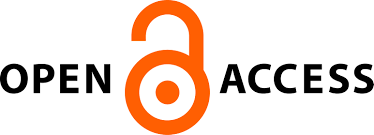The ST(R)E(A)M Methodology in Kindergarten: A Teaching Proposal for Exploratory and Discovery Learning
Article Main Content
This paper attempts to present a proposal to teach the natural concepts of hydrodynamics under the ST(R)E(A)M approach. This is a comprehensive teaching proposal for pre-school teachers, with the possibility of implementation in each class, which helps the teacher to enrich his teaching with activities from science, technology, reading and writing, engineering and mathematics, promoting active participation, critical thinking, collaboration, creativity and developing skills necessary for tomorrow's citizens.
References
-
Archer, L., DeWitt, J., Osborne, J., Dillon, J., Willis, B. & Wong, B. (2010). ‘Doing’ science versus ‘being’ a scientist: Examining 10/11-year-old schoolchildren’s constructions of science through the lens of identity. Science Education, 94(4), 617-639.
Google Scholar
1
-
Bruner, J. (1997). Acts of meaning. Athens: Greek Letters.
Google Scholar
2
-
Bybee, R. W. (2010). Advancing STEM Education: A 2020 Vision. Technology and Engineering Teacher, 70(1), 30-35
Google Scholar
3
-
Christenson, L. & James, J (2015) Building Bridges to Understanding: STEM in the Pre-KClassroom. Young Children. (70)1.
Google Scholar
4
-
Dewey, J. (1990). The School and Society: The Child and the Curriculum. Chicago, IL: University of Chicago Press.
Google Scholar
5
-
Dimitriadis, S. (2015). Learning theories and educational software. Retrieved June 10, 2019 from https://repository. kallipos.gr/handle/11419/3397.
Google Scholar
6
-
Hewitt, P.G., (2009). The Concepts of Physics. University publications of Crete.
Google Scholar
7
-
Kermani, H., & Aldemir, J. (2015). Preparing children for success: integrating science, math, and technology in early childhood classroom. Early Child Development and Care, 185(9), 1504-1527.
Google Scholar
8
-
Kokkotas, P. (2002): Teaching of Natural Sciences II. Modernapproaches to the teaching of Natural Sciences, 3rd edition improved,Ed. Gregory, Athens.
Google Scholar
9
-
Koliopoulos, D., Tandaros. S., Papandreou. M., Ravanis. K., (2004). Preschool Children’s Ideas about Floating: A Qualitative Approach. Journal of Science Education, 5(1), 21-24.
Google Scholar
10
-
Komis, V., & Misirli, A. (2011). Robotique pédagogique et concepts préliminaires de la programmation à l’école maternelle : Une étude de cas basée sur le jouet programmable Bee-Bot. In Proceedings of the 4th conference of “Didactics of Informatics” – DIDAPRO (pp. 271-284). Athènes: New Technologies Editions.
Google Scholar
11
-
Lantz, H. B. (2009). Science, Technology, Engineering, and Mathematics (STEM) Education. What Form? What Function? Retrieved August 10, 2012 from http://www.currtechintegrations.com/pdf/STEMEducationArticle.pdf
Google Scholar
12
-
Lyons, C. D., & Tredwell, C. T. (2015). Steps to implementing technology in inclusive early childhood programs. Computers in the Schools, 32(2), 152-166.
Google Scholar
13
-
Mantzicopoulos, P., Samarapungavan, A. & Patrick, H. (2009). We learn how to predict and be a scientist: Early science experiences and kindergarten children’s social meanings about science. Cognition and Instruction, 27(4), 312-369.
Google Scholar
14
-
Moomaw, Sally and Jaumall Davis. (2010). STEM Comes to Preschool. Young Children, 65 (5), 12-18.
Google Scholar
15
-
Morrison, J. (2006). TIES STEM education monograph series, Attributes of STEM education. Baltimore, MD: TIES
Google Scholar
16
-
Morrison, J., & Bartlett, R. V. (2009). STEM as a curriculum: An experiential approach. Education Week, 28(23), 28–31.
Google Scholar
17
-
Quigley, C. F., Herro, D., & Jamil, F. M. (2017). Developing a conceptual model of STEAM teaching practices. School Science and Mathematics, 117, 1–12.
Google Scholar
18
-
Roberts, A. (2012). A Justification for STEM Education. Technology and Engineering Teacher. May/June 2012.
Google Scholar
19
-
Selley, N. (1993). Why do things float: A study of the place for alternative models in school science. SSR, 74(269), 55-61.
Google Scholar
20
-
Stohlmann, M., Moore, J. T. & Roehrig, H. G. (2012). Considerations for Teaching Integrated STEM Education. Journal of Pre-College Engineering Education Research (J-PEER), 2(1), 28-34.
Google Scholar
21
-
Tsupros, N., Kohler, R., & Hallinen, J. (2009). STEM education: A project to identify the missing components. Intermediate Unit 1: Center for STEM Education and Leonard Gelfand Center for Service Learning and Outreach, Carnegie Mellon University, Pennsylvania.
Google Scholar
22








